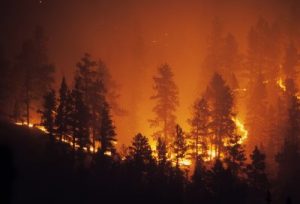In the western US, wildfires contribute to over 70% of ambient fine particles (PM2.5) on days when PM2.5 levels exceeded the National Ambient Air Quality Standards. With future climate change, extended episodes of high-PM2.5 levels from wildfire smoke are estimated to be 57% more frequent and 31% more intense by mid-century. More than 82 million individuals are estimated to be affected by smoke waves 30 years from now, especially in Northern California, Western Oregon and the Great Plains.
Although there are many studies examining the potential impact of climate change on wildfires and air pollution, it is not well understood who will be most affected by the growing threat of wildfires. Identifying communities that are most likely to be affected in the future will inform development of fire management strategies and disaster preparedness programs. In this study, we used a sophisticated atmospheric model to separate PM2.5 in wildfire smoke from those emitted from other sources in all 561 western US counties. We created a new term called “smoke wave” to investigate the characteristics of high-PM2.5 episode due to wildfire smoke in each county. We also developed an index to summarize the levels of risk of wildfire-specific PM2.5 in each county.
Results from this study highlight the potential health impacts of increasing wildfire activity and the need to establish or modify US wildfire management and evacuation programs in high-risk regions. The study also adds to the growing literature arguing that extreme events in a changing climate could have significant consequences for human health.
The results of this study have been broadly disseminated and featured in a number of news articles. Read articles published in the Harvard Gazette, YaleNews, Nature World News, takepart.com, and Science Daily.
The results of this study were published by Climatic Change and the full article can be accessed here: http://link.springer.com/article/10.1007/s10584-016-1762-6
